| Look up corkscrew in Wiktionary, the free dictionary. |
A corkscrew is a tool for drawing stopping corks from bottles.
Contents
Corkscrew may also refer to:
| Look up corkscrew in Wiktionary, the free dictionary. |
A corkscrew is a tool for drawing stopping corks from bottles.
Corkscrew may also refer to:

A roller coaster, or rollercoaster, is a type of amusement ride that employs a form of elevated railroad track designed with tight turns, steep slopes, and sometimes inversions. Passengers ride along the track in open cars, and the rides are often found in amusement parks and theme parks around the world. LaMarcus Adna Thompson obtained one of the first known patents for a roller coaster design in 1885, related to the Switchback Railway that opened a year earlier at Coney Island. The track in a coaster design does not necessarily have to be a complete circuit, as shuttle roller coasters demonstrate. Most roller coasters have multiple cars in which passengers sit and are restrained. Two or more cars hooked together are called a train. Some roller coasters, notably Wild Mouse roller coasters, run with single cars.

A wooden roller coaster is a type of roller coaster classified by its wooden track, which consists of running rails made of flat steel strips mounted on laminated wood. The support structure is also typically made of wood, but may also be made of steel lattice or truss, which has no bearing on a wooden coaster's classification. The type of wood often selected in the construction of wooden coasters worldwide is southern yellow pine, which grows abundantly in the southern United States, due to its density and adherence to different forms of pressure treatment.
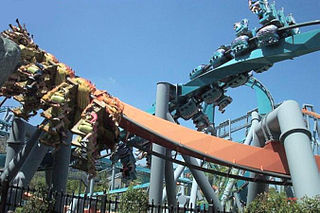
A steel roller coaster is a roller coaster that is defined by having a track made of steel. Steel coasters have earned immense popularity in the past 50 years throughout the world. Incorporating tubular steel track and polyurethane-coated wheels, the steel roller coasters can provide a taller, smoother, and faster ride with more inversions than a traditional wooden roller coaster.
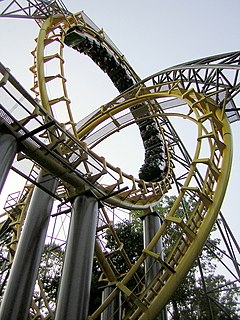
A roller coaster inversion is a roller coaster element in which the track turns riders upside-down and then returns them to an upright position. Early forms of inversions, dating as far back as 1848 on the Centrifugal Railway in Paris, were vertical loops that were circular in nature. They produced massive g-force that was often dangerous to riders, and as a result, the element eventually became non-existent with the last rides to feature the looping inversions being dismantled during the Great Depression. In 1975, designers from Arrow Development created the corkscrew, reviving interest in the inversion during the modern age of steel roller coasters. Since then, the elements have evolved from simple corkscrews and vertical loops to more complex inversions such as Immelmann loops and cobra rolls. Featuring fourteen inversions, The Smiler at Alton Towers holds the world record for the number of inversions on a roller coaster.

An inverted roller coaster is a roller coaster in which the train runs under the track with the seats directly attached to the wheel carriage. This latter attribute is what sets it apart from the older suspended coaster, which runs under the track, but swings via a pivoting bar attached to the wheel carriage. The coaster type's inverted orientation, where the passengers' legs are exposed, distinguishes it from a traditional roller coaster, where only the passengers' upper body parts, including the arms, are exposed.

Valleyfair is a 125-acre (51 ha) amusement park in Shakopee, Minnesota, United States. Owned by Cedar Fair, the park opened in 1976 and now features over 75 rides and attractions including eight roller coasters. Valleyfair also has a water park called Soak City which is included with the price of admission. Cedar Point and Valleyfair were the first two parks in the Cedar Fair chain and a combination of the park names – "cedar" and "fair" – were used to name the company.
Anton Schwarzkopf was a German engineer who founded Schwarzkopf Industries GmbH, a German manufacturer of roller coasters and other amusement rides that were sold to amusement parks and travelling funfairs around the world.

Canobie Lake Park is an amusement park in Salem, New Hampshire, located about 31 miles (50 km) north of Boston. It was founded as a trolley park on the shore of Canobie Lake in 1902. Three local families currently run the park, which draws visitors from throughout the New England region. Canobie Lake Park's age and history inspired author Stephen King to use rides and elements from the park in his Joyland novel. It is one of only thirteen trolley parks still operating in the United States as of 2021.
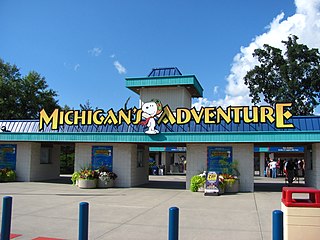
Michigan's Adventure is a 250-acre (1.0 km2) amusement park in Muskegon County, Michigan, about halfway between Muskegon and Whitehall. It is the largest amusement park in the state and has been owned and operated by Cedar Fair since 2001. As of 2019, Michigan's Adventure has 52 rides, more than any other park in the state.
Mad Mouse may refer to:

Double Shot is a type of amusement ride manufactured by S&S - Sansei Technologies.
Roller coaster elements are the individual parts of roller coaster design and operation, such as a track, hill, loop, or turn. Variations in normal track movement that add thrill or excitement to the ride are often called "thrill elements".
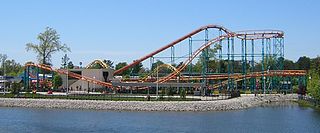
Corkscrew is a steel roller coaster at Michigan's Adventure in Muskegon, Michigan. It was manufactured by Arrow Dynamics. Corkscrew was the park's first roller coaster during the Deer Park days.
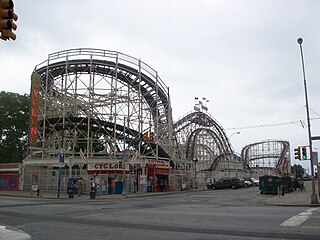
Roller coaster amusement rides have origins back to ice slides constructed in 18th-century Russia. Early technology featured sleds or wheeled carts that were sent down hills of snow reinforced by wooden supports. The technology evolved in the 19th century to feature railroad track using wheeled cars that were securely locked to the track. Newer innovations emerged in the early 20th century with side friction and underfriction technologies to allow for greater speeds and sharper turns. By the mid-to-late 20th century, these elements intensified with the introduction of steel roller coaster designs and the ability to invert riders.

An Impulse roller coaster is a form of a launched inverted roller coaster manufactured by Intamin. The first Impulse roller coaster appeared in Japan, and the ride type has since evolved to include four specific layouts, three of these varieties being built in the United States. It uses LIMs to launch a train out of the station and up a vertical spiral. The train then falls backward, is powered again through the station, and heads up a back tower. The train then falls forward, and continues in this fashion for a total of 2½ cycles per ride. On the final forward launch, with a slightly reduced speed, the train is sent up the front tower, and brakes then deploy on the launch track. The train then slows down and heads back into the station.
This is a list of events and openings related to amusement parks that have occurred in 2012. These various lists are not exhaustive.
This is a list of events and openings related to amusement parks that occurred in 2013. These various lists are not exhaustive.
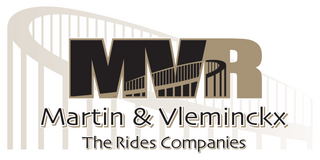
Martin & Vleminckx is a roller coaster manufacturing and construction company headquartered in Montreal, Quebec, Canada with an affiliated office and manufacturing facility in Haines City, Florida, United States, and two subsidiaries, including a warehouse, in China.

Corkscrew with Bayerncurve is a type of roller coaster that was manufactured by Vekoma. It was an adaptation of a similar corkscrew coaster designed by Arrow Development. The first model, Tornado, debuted in 1979 at Walibi Belgium. It was also the first roller coaster in mainland Europe to feature inversions.